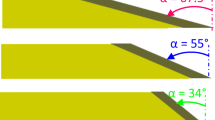Abstract
The quality of edges formed during cutting and slitting of thin polymer webs is important for many industrial applications. To control the edge quality of the separated material, it is necessary to understand cutting. A model is proposed, and the mechanics of cutting are described. Experiments were conducted on polyethylene terephthalate. Photoelastic micrographs were used for qualitative and quantitative observations of the two-dimensional stress distributions. The results of this analysis supported the model for cutting of thin polymer webs. An apparatus was constructed to instrument, monitor and control the web-slitting process. The slitting speed, tension in the web and angle of cut were varied during tests. This allowed a quantitative understanding of the cutting mechanisms to be established. The results of the experiments showed that the in-plane cutting forces were minimally affected by changes in rate or web tension. The angle of cut had a pronounced effect on the in-plane cutting forces and the stability of the cut. The results are a beginning of a mechanistic understanding of deformation taking place during slitting and cutting. The experimentation emphasized an instability in slitting. An understanding of this instability will allow quality web edges with minimal deformation and straight stable cuts to be achieved.
Similar content being viewed by others
References
Feiler, M., “Ein beitrag zur Klarung der Vorgange beim Schneiden duuner flachiger Materialen,”Ph.D. thesis, Technische Hochschule, Stuttgart (1970).
Bollen, D., Deneir, J., Aernoudt, E., andMuylle, W., “Shear Cutting of PET Film,”J. Mat. Sci.,24,2957–2966 (1989).
Tack, L., “Het schaarsnijden van pet-fim: Spannings-en vervormingsanalyse,”Ph.D. thesis, Katholieke Universiteit, Leuven (1986).
Roisum, D.R., The Mechanics of Winding, TAPPI, Atlanta, GA, 175–180 (1994).
Lawn, B., Fracture of Brittle Solids, 2nd ed., Cambridge University Press, Cambridge, 20–50 (1993).
Anderson, T.L., Fracture Mechanics Fundamentals and Applications, 2nd ed., CRC, Boca Raton, FL, 101–116 (1995).
Knott, J.F., Fundamentals of Fracture Mechanics, Butterworth, London (1973).
Burns, S.J., Pollet, J.C., andChow, C.L., “Nonlinear Fracture Mechanics,”Int. J. Fract.,14,311 (1978).
Burns, S.J., “Applications of Thermodynamics to Fracture,”Proc. Conf. Environmental Degradation of Engineering Materials, September 1981, ed. M.R. Louthan, R.P. McNitt andR.D. Sisson, Laboratory for the Study of Environmental Degradation of Engineering Materials, Virginia Polytechnic Institute, Blacksburg, 543 (1981).
Rice, J.R., “Mathematical Analysis in the Mechanics of Fracture,”Fracture, ed. H. Liebowitz, Vol. 2, Ch. 3, Academic Press, New York, 191–311 (1968).
Rice, J.R., “A Path Independent Integral and the Approximate Analysis of Strain Concentration by Notches and Cracks,”J. Appl. Mech.,35,379 (1968).
Irwin, G.R., “Fracture,”Handbuch der Physik, Springer-Verlag, Berlin, 551 (1958).
Barber, J.R., Elasticity, Kluwer Academic, Norwell, MA, 83–95 (1992).
Flamant, Paris Compt. Rend.,114,1465 (1892).
Michell, J.H., “The Inversion of Plane Stress,”Proc. Lon. Math. Soc.,34,134 (1901).
American Society for Testing and Materials, “Standard Test Method for Compressive Strength of Dimension Stone,”American Society for Testing and Materials, Philadelphia, PA,4,C-170 (1994).
Claussen, N., “On the Application of the Diametral-compression Test for Determination of Tensile Strength, Young's Modulus and Poisson's Ratio of Ceramics and Cermets,”Materialpruf,9,140 (1967).
Shipway, P.H. andHutchings, I.M., “Fracture of Brittle Spheres Under Compression and Impact Loading: I. Elastic Stress Distributions,”Phil. Mag.,A 67,1389–1404 (1993).
Shipway, P.H. andHutchings, I.M., “Fracture of Brittle Spheres Under Compression and Impact Loading: II. Results for Lead Glass and Sapphire Spheres,”Phil. Mag.,A 67,1405–1421 (1993).
Bhushan, B., Mechanics and Reliability of Flexible Magnetic Media, Springer-Verlag, New York, 131 (1992).
Chieu, H.C., Burns, S.J., Fiscella, M.D., andBenson, R.C., “A New Model for Deformation Kinetics of Polyethylene Terephthalate Films,”J. Macromolecular Sci.-Phys. B,33,87 (1994).
Author information
Authors and Affiliations
Rights and permissions
About this article
Cite this article
Meehan, R.R., Burns, S.J. Mechanics of slitting and cutting webs. Experimental Mechanics 38, 103–109 (1998). https://doi.org/10.1007/BF02321652
Received:
Revised:
Issue Date:
DOI: https://doi.org/10.1007/BF02321652




